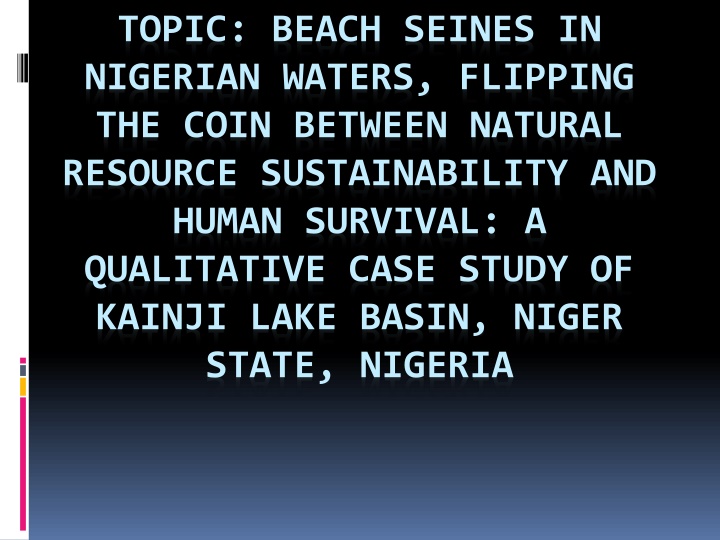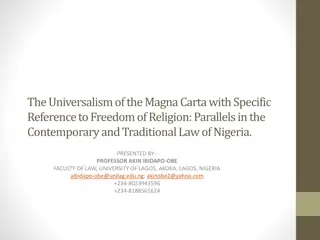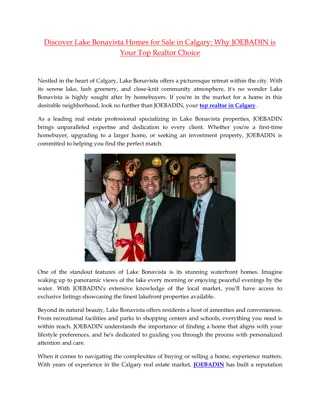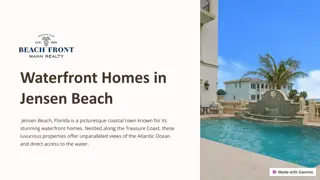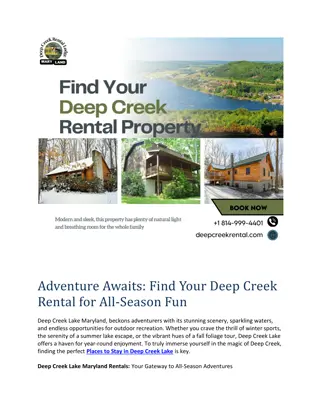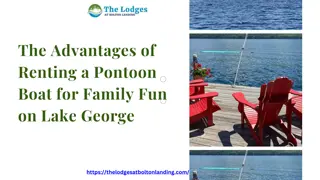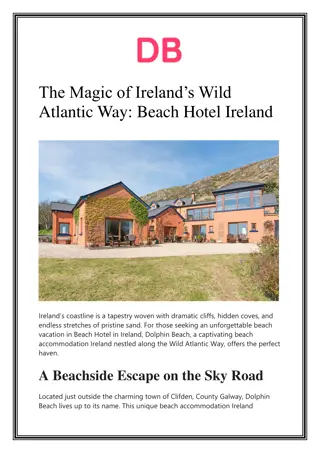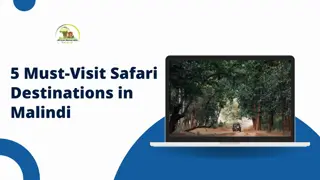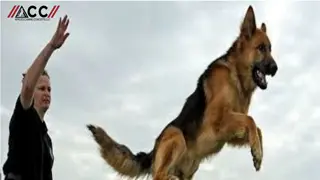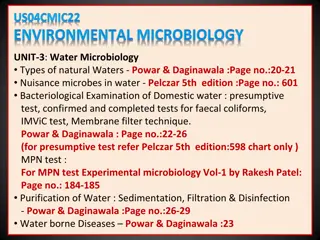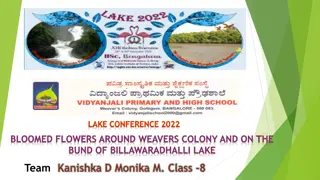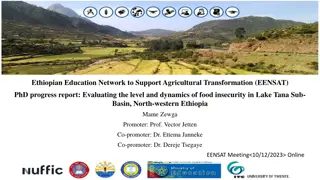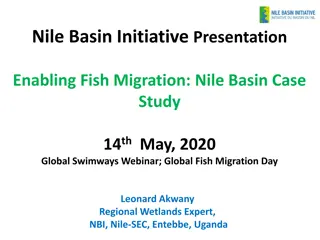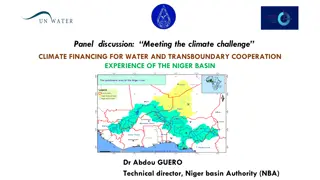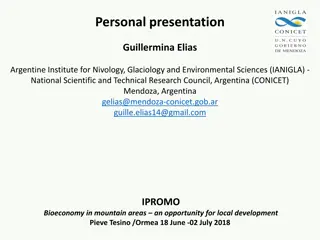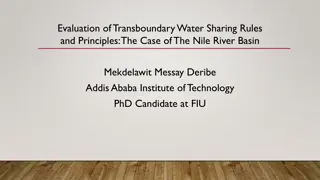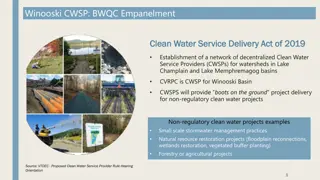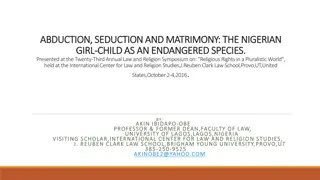Beach Seines in Nigerian Waters: A Case Study of Kainji Lake Basin
Harvesting fishes from waters through beach seines poses a dilemma between resource sustainability and human survival. This qualitative case study explores the impact of beach seines in Nigerian waters, focusing on Kainji Lake Basin in Niger State. The study delves into the balance between fishing practices, natural resource preservation, and community livelihoods, offering insights on the challenges and opportunities in managing this fishing method.
Download Presentation

Please find below an Image/Link to download the presentation.
The content on the website is provided AS IS for your information and personal use only. It may not be sold, licensed, or shared on other websites without obtaining consent from the author.If you encounter any issues during the download, it is possible that the publisher has removed the file from their server.
You are allowed to download the files provided on this website for personal or commercial use, subject to the condition that they are used lawfully. All files are the property of their respective owners.
The content on the website is provided AS IS for your information and personal use only. It may not be sold, licensed, or shared on other websites without obtaining consent from the author.
E N D
Presentation Transcript
TOPIC: BEACH SEINES IN NIGERIAN WATERS, FLIPPING THE COIN BETWEEN NATURAL RESOURCE SUSTAINABILITY AND HUMAN SURVIVAL: A QUALITATIVE CASE STUDY OF KAINJI LAKE BASIN, NIGER STATE, NIGERIA
PAPER PRESENTED AT THE QUALITATIVE VIRTUAL CONFERENCE (TQR), JANUARY 12TH 14TH, 2021 PRESENTED BY: LANDU, EBENEZER JIBRIL Contributors:Landu, E.J.a, Adams-Landu, V.b, Ovwie, P.c, Olowosegun, T.d, Sanni, A. O.e, Ibrahim, S.O.f, Tanko, M.d, and Usman, G.e a. Fishery Economics Department, National Institute for Freshwater Fisheries (NIFFR), New Bussa, Niger State, Nigeria. b. Part-time Faculty Georgia Highlands College, 5441 GA-20, Cartersville. Ga 30121 c. Agricultural Extension Department, Federal College of Fisheries Technology (FCFFT), Niger State, Nigeria. d. Socio- Econs & Extension Department, SEES, National Institute for Freshwater Fisheries (NIFFR), Niger State, Nigeria. e. Sociology Department, SEES, National Institute for Freshwater Fisheries (NIFFR), Niger State, Nigeria f. Statistics and Computer Unit, NIFFR, New Bussa, Niger State.
Introduction Harvesting of fishes from the wide is an old age practice which continues to provide the world with fishes for consumption, livelihood, et al (Karatas, 2015) Several fishing methods exist where beach seine falls into one of the methods adopted by fisher on waters. Beach Seine activity play significant roles in human survival but detrimental to natural stock. Fishers activity on water is like Beach Seining is hinged majorly on survival which has dire consequences like tragedy of the common and depletion (FAO, 2012 Gareth 1968; Anukwonke, 2015) . Where should the coin flip? Sustainability or Survival .
BACKGROUND An act where net is enclosed in an area of water and later drawn ashore or to a vessel/boat One of the most important gear used on lake kainji despite legislation against unorthodox fishing methods (Seisay, 1998) Turner (1996) opined that like cast net, BS causes a huge loss to fish stock when compared with other fishing method Beach Seine (BS) An un- orthodox fishing method (Raji, et at., 2012)
Main Objective A better understanding of the current status of beach seining in Kainji Lake Basin vis a-vis generation of additional information and recommendations for future policy decisions.
Methodology Study carried out within 2 (two) main stratum which lies between longitude 10 00' to 10 25' N and latitude 4 20' to 4 50' E of Kainji Lake Basin. Krejcie and Morgan finite sample size determination was used to determine 334 sample size (Krejcie and Morgan, 1970; Hashim 2010).
Data collection technique 334 responded in 53 localities was enumerated (31 southern stratum and 22 central stratum). At least three (3) questionnaire per locality Cluster sampling was used. Study population has a natural occurrence of cluster which is geographically convenient due to kainji lake basin (Nelson, et.al., 2014)
Map of study area showing geographical co-ordinates
Presentation and interpretation of Data collected using SPSS 20 (Table 1) Learning style/ Structure Demographic structure Age of Settlement Percent(%) Educational Status Percent(%) Above 20 Sex Male Age of Respondent 48-58 37-47 26-36 50.6 Informal education primary education 38.6 30.5 81.1 Years of Experience 6-10 above 10 How experience was acquired Family labour inherited 28.1 25.7 19.8 45.5 44 Marital status married No of wives At least 3 44.3 35.3 56.3 13.2 Extension workers visit none 2018 (1) 2019 (1) 65.9 26.6 7.5 Number of Children 6- 10 Above 10 39.6 23.4
Interpretation of table 1 Likely factors that encourages Beach seine Age of settlement are all above 20 years indicating that they are not new settlers and they are familiar with existing fishing edit of Niger State. Male dominant with (81.1%).No likelihood religious and cultural barrier with population predominantly muslim. 28.1% of age structure ranges between 48-58years meaning they are most likely passing down beach Seine knowledge considering a high informal educational structure (38.6%). With weak education structure, norm, culture, way of life is impacted informally. Many are married (56.3%) with at least 3 wives (13.2%). The number of children has 6-10 (39.6%), while more 10 children (23.4%) which means the head of the family has a huge responsibility and will most like resort to un- orthodox methods cater for the family. On fishing experience data indicated that 6-10years (45.5%), above 10years (44%) with labour predominantly family labour (44.3%) and inherited (35.3%) indicating that experiences were traditionally inherited and informal encouraging beach seine as tradition holds sway.
Likely factors that encourages Beach seine contd Knowledge is passed down traditionally in many communities because many respondent have not seen an extension workers in years. More than half of respondents (65.9%) have not seen an Extension worker meaning no formal reminder on un-orthodox fishing methods Mode of Acquisition/ownership structure of beach seine. A single beach seine costs between =N= 200,000:00 300,000 :00 (two hundred thousand to three hundred thousand naira). At =N= 450:00 to US$1 the cost of a beach seine is between US$450-650. Due to poverty level many fishermen go into alliances to acquire a beach seine while some pay on installment basis which encourages the purchase and use of beach seine. Ownership structure result shows: One off payment (18.6%), installment (37.4%), Owned (30.2%) Partly owned (69.8%). Sources of finance for beach seine purchase shows personal savings (59%), friends/relatives (38%). These funds are largely un-taxed, unbanked and outside government monetary policy control.
factors that encourages Beach seine contd Beach seine as a source of livelihood/income With Sources of information from neighbours (65%) and Distance covered to set beach seine net: < 1 Km (48.2%) and between 1- 2km (32.6%) Income from sales of catch Weekly income during On-Season : =N=112,000 - 140,000 (46.5). Monthly income during On-Season: =N= 450,000-560,000(50.4%), Weekly income during Off-Season: =N= 7,000 -21,000 (73%), 28,000 -35,000(27%) Monthly income during Off-Season: =N=84,000 140,000 (52.1%), =N= 28,000 56,000 (47.9%) Poverty in Nigeria is level high and inflation rate double digit (NBS, 2020) such untaxed income will make respondent flip his coin towards survival since the laws and edits are not enforced in many of the fishing villages these income will go a long way to cushion inflation level and provide basic livelihood income.
Conclusion: Evidence base 2 1 Pic 1. Some youths age between 11 -18 dragging beach seine net to the shore Pic 2. A Female standing inside the beach seine being dragged out of water. Pic 3. Youth collective construction of beach seine net. Pic 4. Beach seine on kainji lake water body. Pic 5. Red arrow in picture 5 shows me (paper presenter) with some youth constructing beach seine net during data collection. 3 4 5
Recommendation Increase Increase aquaculture aquaculture knowledge, knowledge, input to reduce input to reduce natural stock natural stock depletion. depletion. Aquaculture fish Aquaculture fish production will production will reduce beach reduce beach seine, increase seine, increase income of income of fishermen, fishermen, provide taxable provide taxable revenue source revenue source to government to government and a monitoring and a monitoring platform platform Introduction of Introduction of Extension Extension workers to workers to re re- -echo echo natural stock natural stock sustainability sustainability through laws through laws and edits. and edits. Empower Empower inherited inherited informal informal knowledge to knowledge to hand down hand down proper fishing proper fishing method. method. Improve targeted Improve targeted financial support financial support to actual fishers to actual fishers at single digit at single digit interest rate interest rate thereby creating thereby creating employment, employment, reduce beach reduce beach seine on Nigerian seine on Nigerian waters. waters. Have proper, Have proper, relevant, relevant, statistical data statistical data collection collection methods that methods that will capture will capture beach seine beach seine informality informality Effective and Effective and efficient efficient monitoring monitoring system to system to enforce enforce judicious use of judicious use of empowerment empowerment funds given to funds given to farmers. farmers.
Reference Adewumi, A.A. (2015). Aquaculture in Nigeria: Sustainability issues and challenges. Direct Research Journal of Agriculture and Food Science, 3(12),223 231. http://www.directresearchpublisher.org/journal/drjafs Food and Agriculture Organization of the United Nations (FAO) (2018). The state of world fishery and aquaculture contributing to food security and nutrition for all, Rome, 2016, pp. 1-19 FAO (2016). The State of World Fishery and Aquaculture Contributing to Food Security and Nutrition for all. FAO Corporate Document Repository. Retrieved November 16, 2016, from www.fao.org/docrep/003/x6941e02 Seisay, MDB (1998) the Cast Net Fishery, Kainji lake Nigeria, 1970-1997 in Nigerian-German(GTZ) Kainji Lake Fisheries Promotion Project, January 1998, Technical Report Series 12:1-20 National Bureau of Statistics (2017). Annual Abstract of Statistic 2016, vol 1, 98-103. Report date: July 2017. Turner, G.F (1996) Lake Kainji, Nigeria, Nigeria. further progress in Fisheries Statistic Assessment. Nigerian- German (GTZ) Kainji Lake Fisheries Promotion Project Raji, A., Okaeme, A.N., Omorinkoba, W., and Bwala, R.L. (2012) Illegal fishing of Inland Water Bodies Of Nigeria: Kainji Experience. Continental J. Fisheries and Aquatic Science, 6 (1): 47 58. Retrieved February 24, 2020 from http://www.wiloludjournal.com Kituyi, M and Thomson, P. (2018) 90% of fish stocks are used up fisheries subsidies must stop in United Nations conference on Trade and Development. Prosperity for all. Retrieved February, 26, 2020 from https://unctad.org/en/
Thank you for listening
Contact Numbers: +2348066441773 +2348077766880 email:ebenezer.landu@gmail.c om
